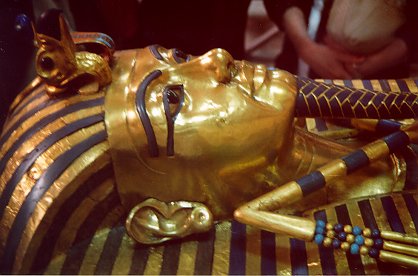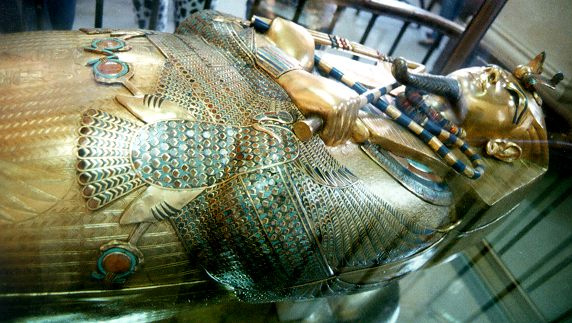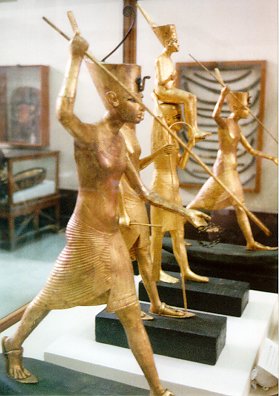
Tutankhamun's Treasures
![]()
The treasures of Tutankhamun have been marveled at since their discovery by Howard Carter on November 4, 1922. It was the first, and to this day the only, royal tomb in the history of Egyptology to be found practically untouched, even though in ancient times it had been the object of no less than two attempts at robbery. The emptying of Tutankhamun's tomb lasted several years and made possible the recovery of about 3500 articles, confirming the tomb as the most exceptional archeological discovery ever made in Egypt. A few of the items are displayed here. |
![]()
 A close-up of Tutankhamun's second innermost coffin, also
referred to as the intermediate coffin. It is made of gilded, laminated wood with
inlays of polychrome glass pastes. The physiognomy of the second coffin differs
markedly from the that of the first (presently located in Tutankhamun's tomb) and third
(shown below) coffins. There is every reason to believe that, as with other objects
from the burial furniture, Tutankhamun was not its intended owner.
A close-up of Tutankhamun's second innermost coffin, also
referred to as the intermediate coffin. It is made of gilded, laminated wood with
inlays of polychrome glass pastes. The physiognomy of the second coffin differs
markedly from the that of the first (presently located in Tutankhamun's tomb) and third
(shown below) coffins. There is every reason to believe that, as with other objects
from the burial furniture, Tutankhamun was not its intended owner. Tutankhamun's third coffin is made of solid,
hammered gold and weighs about 450 pounds. The royal mummy of Tutankhamun was found inside
this coffin. In all three of the coffins, Tutankhamun was represented identically
with the nemes
headdress and the ceremonial beard, folding his arms as his hands grasp the insignia of royal power - the heqa-scepter
in the left and the nekhakha-flail in the right. From Tutankhamun's
forehead a cobra and a vulture stand out, emblems of Wadjet and Nekhbet, the two tutelary deities of
Lower and Upper Egypt. Although Tutankhamun's two innermost sarcophagi are
displayed in the Museum, the
outermost one still holds the mummy of Tutankhamun and resides in his tomb in the Valley of the Kings.
Tutankhamun's third coffin is made of solid,
hammered gold and weighs about 450 pounds. The royal mummy of Tutankhamun was found inside
this coffin. In all three of the coffins, Tutankhamun was represented identically
with the nemes
headdress and the ceremonial beard, folding his arms as his hands grasp the insignia of royal power - the heqa-scepter
in the left and the nekhakha-flail in the right. From Tutankhamun's
forehead a cobra and a vulture stand out, emblems of Wadjet and Nekhbet, the two tutelary deities of
Lower and Upper Egypt. Although Tutankhamun's two innermost sarcophagi are
displayed in the Museum, the
outermost one still holds the mummy of Tutankhamun and resides in his tomb in the Valley of the Kings.Tutankhamun's famous gold
funerary mask rested directly on the pharaoh's mummy inside the third coffin. The pharaoh
wears the classic nemes headdress striped with transversal bands of glass paste
imitating lapis lazuli and is adorned with a wide collar composed of streaks of
semiprecious stones and colored glasses. The eyes are made of quartz and obsidian.
As on the coffins, the lapis-lazuli outline of the eyes reproduces the distinctive
kohl
eye make-up originally applied to protect against the sun's glare but increasingly
employed for its beautifying effect.
 The foremost and furthermost gilded wood statuettes portray Tutankhamun
hunting hippopotamus with a harpoon from a boat made of papyrus. He wears the red crown of
Lower Egypt and stands in a light papyrus skiff such as were used by those hunting with a
throw stick or harpoon in the Delta marshes. The scene depicted (the pharaoh,
protector of order on Earth, spearing the hippopotamus, incarnation of chaos and evil
powers) evokes the legendary fight of Horus against Seth.
For magical reasons, the hippopotamus, is excluded from the composition. The center
gilded, wooded statue portrays Menkeret carrying the mummified pharaoh.
The foremost and furthermost gilded wood statuettes portray Tutankhamun
hunting hippopotamus with a harpoon from a boat made of papyrus. He wears the red crown of
Lower Egypt and stands in a light papyrus skiff such as were used by those hunting with a
throw stick or harpoon in the Delta marshes. The scene depicted (the pharaoh,
protector of order on Earth, spearing the hippopotamus, incarnation of chaos and evil
powers) evokes the legendary fight of Horus against Seth.
For magical reasons, the hippopotamus, is excluded from the composition. The center
gilded, wooded statue portrays Menkeret carrying the mummified pharaoh. Tutankhamun's
Canopic Chest was carved from a single piece block
of delicately veined and semi-translucent calcite, picked out in contrasting dark blue
pigment. The chest contains four alabaster Canopic Jars used for the
burial of the viscera removed during mummification.
Exquisitely modeled in calcite, each lid represents Tutankhamun wearing the nemes
with separately modeled vulture head and uraeus.
The facial features are carefully picked out in black, with dabs of red for the
lips. All four are hollowed out underneath and carry a symbol painted in black on
the shoulder to identify the compartment for which they were intended. The specific
organs stored in the jars were the liver, lungs, stomach and intestines.
Tutankhamun's
Canopic Chest was carved from a single piece block
of delicately veined and semi-translucent calcite, picked out in contrasting dark blue
pigment. The chest contains four alabaster Canopic Jars used for the
burial of the viscera removed during mummification.
Exquisitely modeled in calcite, each lid represents Tutankhamun wearing the nemes
with separately modeled vulture head and uraeus.
The facial features are carefully picked out in black, with dabs of red for the
lips. All four are hollowed out underneath and carry a symbol painted in black on
the shoulder to identify the compartment for which they were intended. The specific
organs stored in the jars were the liver, lungs, stomach and intestines. The gilded wood Canopic Shrine
contained the Canopic Chest pictured above. The outer canopy of this shrine consists
of four corner posts supporting a cavetto cornice surmounted by a continuous frieze of
uraei inlaid with colored glass and faience. Between the posts, on each of the four
sides, stands an elegant guardian goddess of gilded wood - Isis,
Nephthys, Neith and
Selkis, each identified by the
hieroglyph upon her head. Each figure stands feet inwards, arms outstretched in a
gesture of protection with the head gently inclined to either right or left, breaking the
rule of frontality which is basic to Egyptian art. Within this outer framework is a
second layer, the shrine proper, each of its gilded walls decorated in sunk relief with
its own cavetto cornice decorated with a second cobra frieze.
The gilded wood Canopic Shrine
contained the Canopic Chest pictured above. The outer canopy of this shrine consists
of four corner posts supporting a cavetto cornice surmounted by a continuous frieze of
uraei inlaid with colored glass and faience. Between the posts, on each of the four
sides, stands an elegant guardian goddess of gilded wood - Isis,
Nephthys, Neith and
Selkis, each identified by the
hieroglyph upon her head. Each figure stands feet inwards, arms outstretched in a
gesture of protection with the head gently inclined to either right or left, breaking the
rule of frontality which is basic to Egyptian art. Within this outer framework is a
second layer, the shrine proper, each of its gilded walls decorated in sunk relief with
its own cavetto cornice decorated with a second cobra frieze.  A pectoral of Tutankhamun, who, with his
advisors, was at pains to emphasize the return to diverse worship of the sun and other
deities after Akhenaten's experiment with monotheistic Atenism. Two forms of the
sun-god are incorporated into this pendent: the scarab beetle Khepri, god of the rising
sun who each day pushed the solar disc into the sky, and the winged solar disk with uraei
most commonly known as Horus
Behdety or Horus of Edfu, son and heir of Ra and mighty defender of his royal father
against Set. The scarab in this pectoral is made from a green stone, the color
symbolizing rebirth. The scarab is winged and holds Tutankhamun's cartouches in
front of itself. The feathered wings of the scarab are supported by the kneeling
figures of Nephthys and Isis, respectively to the left and right of the scarab, wearing
the hieroglyphs that signify their names on their heads. The decoration of the
pendant is executed in the cloisonné technique, with thin gold wires forming small cells
that were typically filled with colored glass paste.
A pectoral of Tutankhamun, who, with his
advisors, was at pains to emphasize the return to diverse worship of the sun and other
deities after Akhenaten's experiment with monotheistic Atenism. Two forms of the
sun-god are incorporated into this pendent: the scarab beetle Khepri, god of the rising
sun who each day pushed the solar disc into the sky, and the winged solar disk with uraei
most commonly known as Horus
Behdety or Horus of Edfu, son and heir of Ra and mighty defender of his royal father
against Set. The scarab in this pectoral is made from a green stone, the color
symbolizing rebirth. The scarab is winged and holds Tutankhamun's cartouches in
front of itself. The feathered wings of the scarab are supported by the kneeling
figures of Nephthys and Isis, respectively to the left and right of the scarab, wearing
the hieroglyphs that signify their names on their heads. The decoration of the
pendant is executed in the cloisonné technique, with thin gold wires forming small cells
that were typically filled with colored glass paste.© All pictures are Copyright 1998 - 2001 Grisel Gonzalez